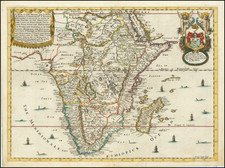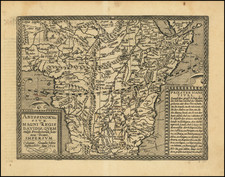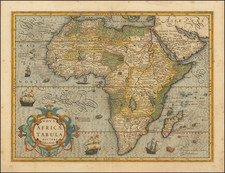Scarce folding map of Africa, colored by countries, published in Paris by P. Raoul.
This French map of Africa, from around 1910, offers a detailed representation of the intricate web of maritime routes that underpinned the colonial trade networks of the early 20th century. The map prominently features the shipping lanes connecting Europe to various African ports, highlighting the economic interdependencies and colonial interests of the time.
The legend indicates the significance of various lines, with solid and dashed representations denoting different shipping companies, such as the "Compagnie Générale Transatlantique" and the "Société Générale de Transports Maritimes à Vapeur," both crucial in ferrying goods and passengers. The map also underscores the strategic submarine telegraph cables, the principal lines of which are clearly marked, reflecting the importance of communication in maintaining colonial administration and facilitating international trade.
Moreover, the color-coded "DIVISIONS POLITIQUES" section illustrates the political dominion of European powers over African territories. Each color corresponds to a different colonial power, with France, Germany, Great Britain (Angleterre), Spain (Espagne), independent states, Italy, Portugal, and Turkey (Turquie) demarcated, revealing a continent carved up by European interests.
The inclusion of terrestrial features such as mountain ranges, rivers, and their characteristics—indicated by symbols for rapids, sources, and estuaries—provides additional context for the navigability and geographic challenges of the continent. Key cities and regions, symbolized by squares or circles, are marked based on their political or economic importance, further accentuating the colonial perspective from which this map was drawn.
The map serves as a historical document, revealing the extent to which European nations went to chart, connect, and control African territories. It illustrates not only the geography of the continent but also the geopolitical realities of the time, when Africa was seen primarily through the lens of European economic and strategic interests.









![Affrika třetj djl okrsslku zemského [Czech Language Edition]](https://storage.googleapis.com/raremaps/img/small/93470.jpg)
![[Africa] (2 maps - Ancient & Modern)](https://storage.googleapis.com/raremaps/img/small/70579.jpg)

![(South Atlantic) Nieuwe Wassende Graadige Pas-kaart van de Kust van Guinea en Brasilia strekkende van Cap Verde tot de Cap de Bon-Esperance en Verders van Rio de Berbice tot Rio de la Plata. [New Increasing Latitude Sea Chart of the Coast of Guinea and Brazil stretching from Cape Verde to the Cape of Good Hope and Further from the Berbice River to the Rio de la Plata.]](https://storage.googleapis.com/raremaps/img/small/99819.jpg)

